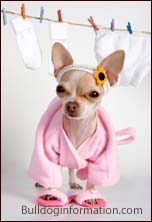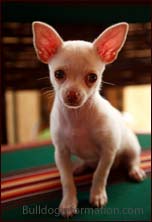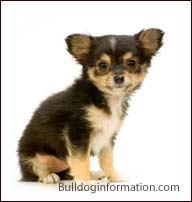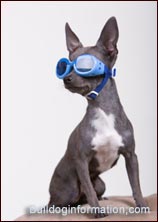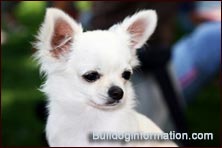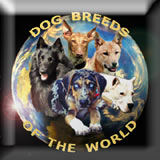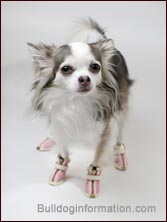Chihuahua
(Smooth-coat Chihuahua, Long-haired Chihuahua)
Famous for being the smallest dog in the world, this fragile, tiny dog is named after the Mexican state from which it was first exported in the mid 1800s.
The exact origin of the Chihuahua remains a mystery. One theory is that the breed arrived in the Americas with the Spanish armies of Hernando Cortes in 1519.
Other authors believe it were the Chinese who were fond of dwarfing animals and plants, who brought this miniaturized dog to America, long before the arrival of the Europeans.
Yet another theory is that the breed was developed by the Aztecs and Toltecs. Explorers have reported the existence of dogs called the Techichi, a type of rodent, which the natives "raised, castrated and ate". However, the earliest representations found depicting an animal that resembles the Chihuahua appear not to be of the canine species, but a tree-climbing, mute rodent.
In fact, Chichi was an Aztec root word for mammal. Further studies indicate that the Aztecs had only three domisticated quadrupeds, all of which carried the root "itzcuintli", which the Spaniards erronuously translated as "dog".
Other authorities feel it is just a miniaturized version of native pariah dogs. It is indeed very similar to dogs such as the Podengo of Portugal.
The smooth-coated variety appears to have been the original one, which was probably crossed to other Toy dogs, such as Papillons or Pomeranians, to produce the long-coated version.
The breed was first known in the States around the 1880s. The first Chihuahua registered by the AKC in 1904 was named "Midget".
The Chihuahua Club of America was established in 1923. The Chihuahua is one of the few 'exotic' dog breeds that was first more popular in America than in the UK. Early crosses were made to other toy breeds, probably Papillons and Pomeranians, to create the long-coated version.
Long-haired Chihuahua puppy
The ears are held erect when alert and at a 45° angle at the sides when at repose.
A remarkable feature of this breed is the molera, or fontanella (a soft, open spot in the skull), on top of the head, much like human babies. Not all Chihuahuas are born with the molera and the soft spot may vary in shape and size from one individual to the other. It is important to note that even when the molera is present it does not predispose the Chihuahua to hydrocephalus. Originally the molera was considered a distinctive feature of the breed.
Types of Chihuahuas
Chihuahuas are the smallest dog breed in the world, averaging 2 to 6 lb (1 to 3 kg) in weight and 6 - 9 in (15-23cm) in height. A well balanced dog does not exceed six pounds. In the show ring disqualification is based upon weight, not size. A chihuahua should appear as compact and well-proportioned, without conveying the idea of dwarfism.
Character and Temperament
.
.
.
.
The Canine Information Library 2003-2008 © All rights reserved. Original idea, design and development by C. Marien-de Luca. Photos © Teresa Guerrero (Chihuahua in bathrobe); Hugo Chang (Chihuahua puppy); Eric Isselée (long-haired Chihuahua puppy); Nicole Weiss (blue and white long coat Chihuahua); Photopix (chocolate Chihuahua); Magic Web Solutions (Blue Chihuahua); Aleš Novak (white Chihuahua). No part of bulldoginformation.com may be copied, distributed, or reproduced on another website without the owner's written permission.
The Everything Chihuahua Book:
A Complete Guide to Raising, Training, And Caring for Your Chihuahua (Everything: Pets)
by Joan Hustace Walker(Author)
Small Dogs, Big Hearts:
A Guide to Caring for Your Little Dog , Revised Edition
Chihuahuas are very alert and courageous dogs, with a terrier-like temperament. They get along well with other Chihuahuas, but less well with other dogs, as they can be very possessive and jealousies may arise. Not recommended with young, boisterous children, but fine with responsible older children.
Because of its small size, the Chihuahua is an excellent pet for apartment dwellers and elderly. Chihuahuas can be easily paper-trained.
Pocket Pups:
The Definitive Guide to Diminutive Dogs (Paperback)
Chihuahua Colors and Markings
Any color is accepted, either solid, marked or splashed.
Traditional (preferred) Chihuahua colors or color patterns are: fawn, tri (black and tan with white markings), black and tan, chocolate, sable, silver, black, brindle fawn and black with white markings. Each color can come with white markings or a black mask and/or black hair along the back, called saddle or saddleback, although the latter has become less frequent.
Long-haired, blue
and white Chihuahua
Chihuahua color patterns and markings are expressed with the following terminology (see also: Dog coat colors):
Irish Marking: a solid-colored chihuahua with with white markings on the legs, chest, tail tip, and a blaze on the face and a ring around the neck.
Brindle: striped like a tiger. Different shades and colors can form the stripes.
Parti-colored (piebald, pinto): irregular patches of color on a white background. The patches of color should be well defined and cover the head as well as one-third of the body. The spots themselves can be brindled as well. Parti-colored or piebald shows much larger parts of white than irish marking.
Sable or Sabling: Sable chihuahuas have black-tipped hairs or black hairs on a background of silver, cream or tan. Not to be confused with saddle: a large patch of a darker color across the back of the dog more or less in the form of the saddle (as in some pugs).
Merle: a speckled or dappled coat, often combined with a change in eye color of the dog. The merle coloration is recognized by the AKC. However, Chihuahuas carrying the merle gene cannot be registered nor shown in Germany, England, Wales, Scotland, Australia and Canada, nor in Mexico (the country of origin of the breed) due to possible health issues (deafness, blindness) associated with the gene responsible for the merle coloration. Indeed, merle reduces the pigment not only in haircoat, but also in skin, eyes, etc. As the most common cause of congenital deafness in dogs is pigment related, homozygous merles (double merles) run a higher risk to be deaf. It does not at all mean that all homozygous merles will be born deaf, just that the occurence will be higher. A few homozygous merle dogs have microphthalmia or small eyes, which typically are malformed and have no visual function.
Head shape and body type
The head shape required by the breed standard is a 'rounded apple dome' head, with a short nose and a head shape similar to that of an apple. Standard Chihuahuas are therefore sometimes referred to as apple head chihuahuas. The term deer head is used to describe any Chihuahua that does not have the characteristic apple shaped head. Deer head Chihuahuas have a longer nose and a shape of head that reminds a miniature young deer.
Coat length
Chihuahuas come in two hair varieties: a long-haired type and a short-haired type. The long-haired variety (either flat or slightly curly) is rarer than the short coat type. The long-haired Chihuahua has fringed ears, as well as a longhaired tail, legs and frill under its neck and underbody.
Long-haired chocolate Chihuahua
Size
Teacup, toy, miniature or pocket Chihuahuas are just marketing labels. Chihuahuas are by definition a toy breed and exist only in one size. Chihuahuas do vary in size, but dogs that are too tiny will usually also display other health concerns.
Rare Chihuahua colors are red, white, cream, and blue.
Books for Chihuahua Owners:
